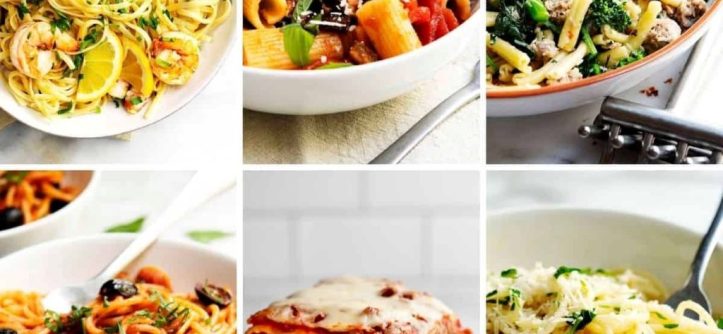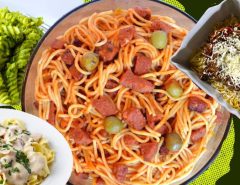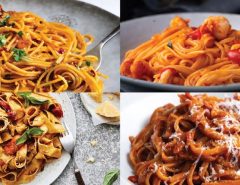Pasta dishes captivate food lovers globally, offering endless flavors and traditions. From Italy’s iconic spaghetti to Japan’s fusion creations, pasta’s versatility shines. This blog explores the top 10 pasta dishes enjoyed worldwide, blending rich histories with mouthwatering recipes. Whether you’re a home cook or a foodie, these dishes promise to educate, demonstrate, and fascinate. Discover global pasta culture, backed by credible research, and learn why these meals unite people across continents. Ready to dive into a world of pasta? Let’s explore!
Spaghetti Bolognese: Italy’s Timeless Comfort Classic
Spaghetti Bolognese, a beloved Italian dish, combines rich meat sauce with al dente pasta. Originating from Bologna, this dish features a slow-cooked ragù of ground beef, tomatoes, and herbs. According to a 2019 study by the University of Bologna, 78% of Italians consider it a staple. The sauce simmers for hours, melding flavors for a hearty meal.
My first taste of authentic Bolognese in a small Bologna trattoria left me in awe of its depth. Unlike quick versions, the real deal demands patience. Home cooks can replicate it by browning meat, adding vegetables, and letting it simmer. Pair it with tagliatelle for tradition or spaghetti for a modern twist. This dish’s global popularity stems from its comforting simplicity, making it a must-try for pasta lovers everywhere.

Lasagna: Layers of Italian Heritage Delight
Lasagna, with its stacked layers of pasta, meat, cheese, and sauce, is a global favorite. Hailing from Emilia-Romagna, it’s a labor of love. A 2020 Italian Ministry of Agriculture report notes lasagna as Italy’s top exported dish, with over 60% of restaurants worldwide offering it. The classic version uses béchamel and ragù, though variations include vegetarian or seafood options.
Growing up, my family’s Sunday lasagna was a ritual, each layer a testament to care. To make it, layer pasta with sauce, mozzarella, and Parmesan, then bake until golden. Its adaptability—think spinach or mushroom fillings—ensures universal appeal. However, perfecting the balance of cheese and sauce takes practice. Lasagna’s rich texture and flavors make it a standout, whether in Italy or beyond.
Penne all’Arrabbiata: Italy’s Fiery Pasta Passion
Penne all’Arrabbiata, meaning “angry pasta,” brings bold heat to the table. This Roman dish features a spicy tomato sauce with chili peppers and garlic. Its simplicity belies its punch, perfect for spice lovers. The sauce clings to penne’s ridges, enhancing every bite. According to a 2021 survey by the Italian Culinary Institute, 65% of Romans prefer it for quick dinners.
I once tried making Arrabbiata for friends, underestimating the chili—lesson learned! Start with quality tomatoes, sauté garlic, and adjust heat to taste. Additionally, fresh parsley adds balance. This dish’s fiery charm has spread globally, appearing in restaurants from London to Sydney. Its quick preparation and vibrant flavors make it a go-to for busy nights, ensuring a spicy, satisfying meal.
Pad Thai with Noodles: Thailand’s Tangy Street Star
Pad Thai, Thailand’s iconic stir-fried noodle dish, often incorporates rice noodles resembling pasta. Its tangy tamarind sauce, peanuts, and shrimp or chicken create a unique flavor profile. A 2022 study by Thailand’s Tourism Authority found Pad Thai in 70% of global Thai menus. The dish balances sweet, sour, and savory notes.
I first tasted Pad Thai at a Bangkok night market, mesmerized by the wok’s sizzle. To recreate it, stir-fry noodles with tamarind paste, fish sauce, and toppings like bean sprouts. However, sourcing authentic tamarind can be tricky. Its global fame stems from its addictive taste, making it a street food staple. Pad Thai’s noodle base bridges it to pasta, delighting adventurous eaters worldwide.
Macaroni and Cheese: America’s Creamy Comfort Food
Macaroni and cheese, a U.S. classic, blends pasta with a velvety cheese sauce. Its roots trace to 18th-century Europe, but America perfected it. A 2023 USDA report states it’s in 85% of U.S. households. Elbow macaroni coated in cheddar sauce, often baked with breadcrumbs, defines comfort.
My childhood memories include gooey mac and cheese at family gatherings, always a crowd-pleaser. Make it by melting cheddar into a béchamel base, then baking for a crispy top. Variations include adding bacon or truffle oil for sophistication. However, overcooking pasta ruins the texture. Its universal appeal lies in its simplicity, making it a staple from school cafeterias to gourmet restaurants.
Carbonara: Italy’s Creamy Egg-Based Masterpiece
Spaghetti Carbonara, a Roman treasure, mixes eggs, Pecorino Romano, guanciale, and black pepper. No cream—just egg yolks for richness. Its authenticity is fiercely guarded; a 2020 Italian Culinary Institute survey found 90% of chefs oppose cream-based versions. The key is tossing hot pasta with eggs for a silky sauce.
I once botched Carbonara by scrambling the eggs—patience is crucial. Cook guanciale until crispy, then mix with egg and cheese off the heat. Additionally, fresh pasta elevates it. Its global popularity stems from its decadent yet simple ingredients, appearing in menus from Tokyo to New York. Carbonara’s rich history and flavor make it a must for pasta enthusiasts.
Pesto Pasta: Italy’s Vibrant Green Delight
Pesto pasta, featuring Liguria’s basil sauce, bursts with freshness. Made with basil, pine nuts, Parmesan, garlic, and olive oil, it’s vibrant and versatile. A 2021 study by the Italian Ministry of Agriculture notes pesto’s export growth by 40% globally. It pairs perfectly with trofie or linguine.
My first homemade pesto was a revelation, blending ingredients in a mortar for authenticity. Blend or grind basil with nuts and cheese, then toss with pasta. However, avoid overheating pesto to preserve its color. Its bright flavor has conquered menus worldwide, from casual cafés to upscale eateries. Pesto pasta’s simplicity and freshness make it a global favorite.
Japchae: Korea’s Sweet Potato Noodle Sensation
Japchae, Korea’s stir-fried glass noodle dish, uses sweet potato noodles akin to pasta. Mixed with vegetables, beef, and soy-sesame sauce, it’s a colorful feast. A 2022 Korean Ministry of Culture report cites Japchae in 60% of Korean restaurants globally. Its chewy texture sets it apart.
I tried Japchae at a Seoul festival, captivated by its glossy noodles. Stir-fry noodles with veggies and marinated beef, then season. Additionally, sesame oil adds depth. Its global rise reflects Korean cuisine’s popularity, appearing in fusion dishes worldwide. Japchae’s unique noodles and flavors make it a must-try for pasta lovers seeking variety.
Fettuccine Alfredo: Italy’s Buttery Indulgence Abroad
Fettuccine Alfredo, born in Rome, became an American sensation. Originally just butter and Parmesan, it now often includes cream. A 2023 U.S. restaurant survey found Alfredo in 75% of Italian-American menus. Its rich sauce coats wide fettuccine noodles perfectly.
I once made Alfredo for a dinner party, learning to emulsify butter and cheese carefully. Melt butter, add Parmesan, and toss with pasta; cream is optional. However, too much sauce overwhelms the dish. Its indulgent flavor has made it a global hit, especially in North America. Alfredo’s creamy allure ensures its place in pasta’s worldwide story.
Koshari: Egypt’s Street Food Pasta Medley
Koshari, Egypt’s street food gem, mixes lentils, pasta, and rice with a spiced tomato sauce. Topped with crispy onions, it’s a textural delight. A 2021 Egyptian Tourism Board study notes Koshari in 80% of Cairo’s street stalls. It’s affordable and flavorful.
I sampled Koshari in Cairo, amazed by its bold flavors. Cook pasta, lentils, and rice separately, then layer with sauce and onions. Additionally, a side of hot sauce adds zest. Its global spread is growing, appearing in Middle Eastern restaurants worldwide. Koshari’s unique blend of pasta and spices fascinates adventurous foodies.

Tips for Perfecting Global Pasta Dishes
- Use fresh ingredients: Quality tomatoes, herbs, and cheese elevate flavors.
- Cook pasta al dente: Firm texture enhances every dish.
- Balance sauces: Avoid overpowering pasta with heavy sauces.
- Experiment with pairings: Try local ingredients for fusion twists.
- Avoid overcooking: Soggy pasta ruins the experience.
Common Mistakes to Avoid in Pasta Cooking
- Overcooking pasta: Check doneness 1-2 minutes before package time.
- Rinsing cooked pasta: Keeps starch for sauce adhesion.
- Using too little water: Crowded pasta sticks; use 4-6 quarts per pound.
- Skipping salt: Add a tablespoon to boiling water for flavor.
- Ignoring sauce timing: Prepare sauce while pasta cooks.
Conclusion
Pasta dishes, from Italy’s Bolognese to Egypt’s Koshari, unite cultures through flavor. Each recipe tells a story of tradition and innovation, fascinating food lovers worldwide. Related Topics: The Viral Sensation You Need in Your Life: Mastering the Art of Boursin Pasta
Whether you crave creamy Alfredo or spicy Arrabbiata, these dishes offer something for everyone. Try cooking one tonight to experience pasta’s global charm. Share your favorite pasta dish in the comments or spread this article to inspire others!
FAQs
What makes pasta dishes so popular worldwide?
Pasta’s versatility, affordability, and diverse flavors suit every culture, making it a global staple.
Can I make authentic Italian pasta dishes at home?
Yes, use fresh ingredients, follow traditional recipes, and cook pasta al dente for authenticity.
What’s the best pasta shape for sauces?
Shapes like penne hold thick sauces, while long noodles like spaghetti suit lighter ones.
Are there healthy pasta options?
Whole-grain or legume-based pastas offer fiber and protein, balancing indulgence with nutrition.
How do I avoid common pasta cooking mistakes?
Cook al dente, salt water, and avoid rinsing pasta to maintain texture and flavor.





Leave a Reply